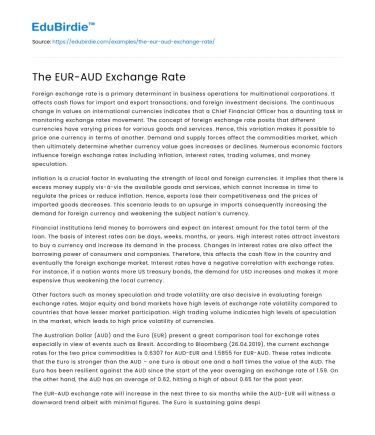Foreign exchange rate is a primary determinant in business operations for multinational corporations. It affects cash flows for import and export transactions, and foreign investment decisions. The continuous change in values on international currencies indicates that a Chief Financial Officer has a daunting task in monitoring exchange rates movement. The concept of foreign exchange rate posits that different currencies have varying prices for various goods and services. Hence, this variation makes it possible to price one currency in terms of another. Demand and supply forces affect the commodities market, which then ultimately determine whether currency value goes increases or declines. Numerous economic factors influence foreign exchange rates including inflation, interest rates, trading volumes, and money speculation.
Inflation is a crucial factor in evaluating the strength of local and foreign currencies. It implies that there is excess money supply vis-à-vis the available goods and services, which cannot increase in time to regulate the prices or reduce inflation. Hence, exports lose their competitiveness and the prices of imported goods decreases. This scenario leads to an upsurge in imports consequently increasing the demand for foreign currency and weakening the subject nation’s currency.
Financial institutions lend money to borrowers and expect an interest amount for the total term of the loan. The basis of interest rates can be days, weeks, months, or years. High interest rates attract investors to buy a currency and increase its demand in the process. Changes in interest rates are also affect the borrowing power of consumers and companies. Therefore, this affects the cash flow in the country and eventually the foreign exchange market. Interest rates have a negative correlation with exchange rates. For instance, if a nation wants more US treasury bonds, the demand for USD increases and makes it more expensive thus weakening the local currency.
Other factors such as money speculation and trade volatility are also decisive in evaluating foreign exchange rates. Major equity and bond markets have high levels of exchange rate volatility compared to countries that have lesser market participation. High trading volume indicates high levels of speculation in the market, which leads to high price volatility of currencies.
The Australian Dollar (AUD) and the Euro (EUR) present a great comparison tool for exchange rates especially in view of events such as Brexit. According to Bloomberg (26.04.2019), the current exchange rates for the two price commodities is 0.6307 for AUD-EUR and 1.5855 for EUR-AUD. These rates indicate that the Euro is stronger than the AUD – one Euro is about one and a half times the value of the AUD. The Euro has been resilient against the AUD since the start of the year averaging an exchange rate of 1.59. On the other hand, the AUD has an average of 0.62, hitting a high of about 0.65 for the past year.
The EUR-AUD exchange rate will increase in the next three to six months while the AUD-EUR will witness a downward trend albeit with minimal figures. The Euro is sustaining gains despite Eurozone’s economic and political apprehensions. Events such as the civil unrest in France, Spanish general election, unexpected dip in German industrial output, and Brexit are the source of the Euro fluctuations. These apprehensions make the Euro unappealing, but the decision of the Reserve Bank of Australia (RBA) to reduce interest rates leaves the AUD less attractive in comparison. Considering the negative relationship of interest rates and exchange rates, this decision will reduce the demand for the AUD and thus strengthen the Euro. In addition, decisions by central banks take time to process and investors know that the interest rates will remain in effect for the near future. Therefore, a drastic reversal of the decision has low probability making the EUR-AUD grow stronger in most trading days.
The European Union (EU) and United Kingdom (UK) leaders agreed to push back Brexit to end of October. Hence, the Eurozone trading volume remains in force until then, and currency speculation continues with all factors intact. The highly volatile nature of the Eurozone due to its diverse economies renders the Euro unpredictable. However, the EU has managed to create an economic zone that uses similar currency making it less difficult for investors to speculate. The UK is the fifth largest economy in the world and until a big event such as Brexit culminates, the ramifications may then be dire. Thus, the EUR-AUD exchange rate will increase in the next few months albeit with muted periods.
Forecasted favorable business conditions and investor confidence fail to meet expectations as the year progresses. A 2019 February survey by the National Australia Bank (NAB) confirms the decline in business confidence, which has implications for future investment decisions. The EUR-AUD exchange rate remained muted in March despite a slump by Australian home loans. Such events reaffirm that the EUR-AUD exchange rate will increase while the AUD-EUR will go down. However, both exchange rates will witness fluctuations with relatively low variations.






 Stuck on your essay?
Stuck on your essay?

